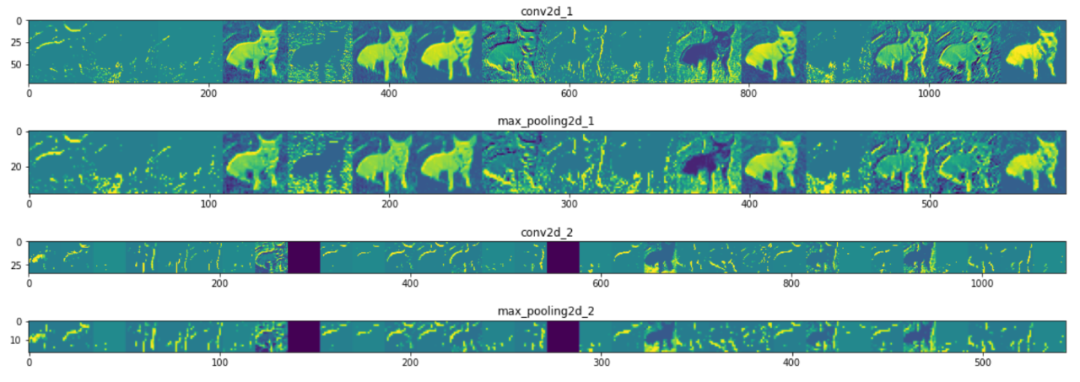程序员宝藏库:https://github.com/Jackpopc/CS-Books-Store
现如今,谈起人工智能,对于大多数人来说已经不再陌生。
而作为其中比较热门的计算机视觉,更是吸引了一大批从业者。
但是,其中绝大多部分都“不知所以然”。搭建起开发环境,照搬一段代码,就认为大功告成,但是,到底数据进入网络中发生了什么?特征是什么样的,很多人都回答不上来。
本文,就来教大家如何如何可视化 CNN 网络层的特征图。
教程
废话不多说,我们先来建立一个网络模型:
model = tf.keras.models.Sequential([ tf.keras.layers.Conv2D(8,(3,3),激活='relu',input_shape =(150,150,3)), tf.keras.layers.MaxPooling2D(2,2), tf.keras.layers.Conv2D(16,(3,3),激活='relu'), tf.keras.layers.MaxPooling2D(2,2), tf.keras.layers.Conv2D(32,(3,3),激活='relu'), tf.keras.layers.MaxPooling2D(2,2), tf.keras.layers.Flatten(), tf.keras.layers.Dense(1024,activation ='relu'), tf.keras.layers.Dense(512,activation ='relu'), tf.keras.layers.Dense(3,activation ='softmax') ])
复制代码
该模型的概括如下:
如上所示,我们具有三个卷积层,其后是 MaxPooling 层,两个全连接层和一个最终输出全连接层。
我们需要训练和拟合模型。因此,首先运行模型,然后才能得到特征图。只不过,在这里不演示这部分过程。
要生成特征图,需要用到model.layersAPI,接下来了解如何访问 CNN 中间层。
获取 CNN 网络层的名称
layer_names = [layer.name for layer in model.layers]layer_names
复制代码
我们会得到如下结果:
['conv2d', 'max_pooling2d', 'conv2d_1', 'max_pooling2d_1', 'conv2d_2', 'max_pooling2d_2', 'flatten', 'dense', 'dense_1', 'dense_2']
复制代码
获取 CNN 网络层的输出
layer_outputs = [layer.output for layer in model.layers]
复制代码
这将返回 CNN 网络层的输出对象,它们不是真正的输出,但是它们告诉我们将产生输出的函数。我们将结合这一层,输出到可视化模型中,构建可视化特征图。
[<tf.Tensor 'conv2d/Relu:0' shape=(None, 148, 148, 8) dtype=float32>, <tf.Tensor 'max_pooling2d/MaxPool:0' shape=(None, 74, 74, 8) dtype=float32>, <tf.Tensor 'conv2d_1/Relu:0' shape=(None, 72, 72, 16) dtype=float32>, <tf.Tensor 'max_pooling2d_1/MaxPool:0' shape=(None, 36, 36, 16) dtype=float32>, <tf.Tensor 'conv2d_2/Relu:0' shape=(None, 34, 34, 32) dtype=float32>, <tf.Tensor 'max_pooling2d_2/MaxPool:0' shape=(None, 17, 17, 32) dtype=float32>, <tf.Tensor 'flatten/Reshape:0' shape=(None, 9248) dtype=float32>, <tf.Tensor 'dense/Relu:0' shape=(None, 1024) dtype=float32>, <tf.Tensor 'dense_1/Relu:0' shape=(None, 512) dtype=float32>, <tf.Tensor 'dense_2/Softmax:0' shape=(None, 3) dtype=float32>]
复制代码
为了生成特征图,我们必须构建一个可视化模型,该模型以图像为输入,并用上述 layer_outputs 作为输出函数。
这里要注意的重要一点是,我们总共有 10 个输出,9 个中间输出和 1 个最终分类输出。因此,我们将有 9 个特征图。
CNN 网络层特征图可视化
feature_map_model = tf.keras.models.Model(input=model.input, output=layer_outputs)
复制代码
上面的代码汇总了我们在开始时创建的 CNN 模型的输入和输出函数。
layer_outputs 中总共有 10 个输出函数。将该图像作为输入,然后使该图像以串行方式依次通过所有这 10 个输出函数。
最后一个输出函数是模型本身的输出。因此,总共有 9 个中间输出函数,因此有 9 个中间特征图。
这意味着我们提供给 feature_map_model 的任何输入,输出将以 9 个特征图的形式呈现。
现在,我们将准备一张图像,以将其作为上述 feature_map_model 的输入:
image_path= r"path of the image from desktop or internet."img = load_img(image_path, target_size=(150, 150)) input = img_to_array(img) input = x.reshape((1,) + x.shape) input /= 255.0
复制代码
在上面的代码中,我们已将图像加载到变量“输入”中,将其转换为数组,扩展了图像的尺寸以匹配中间层的尺寸,最后,在将图像输入到层。
现在,让我们将其输入到创建的模型中:
feature_maps = feature_map_model.predict(input)
复制代码
现在已经生成了特征图,让我们检查每个输出的特征图的形状。
for layer_name, feature_map in zip(layer_names, feature_maps):print(f"The shape of the {layer_name} is =======>> {feature_map.shape}")
复制代码
这会输出中间网络层的名称以及特征层的形状:
生成特征图
我们需要生成卷积层的特征图,而不需要生成全连接层的特征图:
for layer_name, feature_map in zip(layer_names, feature_maps): if len(feature_map.shape) == 4
复制代码
每个特征图都有 n 个通道,并且在特征图形状的末尾给出该数字“ n”。这是特定图层中特征的数量。
例如。feature_map[0].shape=(1,148,148,8)。
这意味着这是一个具有 8 维的图像。因此,我们需要遍历此图像以分离其 8 张图像。
for layer_name, feature_map in zip(layer_names, feature_maps): if len(feature_map.shape) == 4 k = feature_map.shape[-1] for i in range(k): feature_image = feature_map[0, :, :, i]
复制代码
直接生成的特征图在视觉上非常暗淡,因此人眼无法正确看到。因此,我们需要对提取特征图像进行标准化。
feature_image-= feature_image.mean()feature_image/= feature_image.std ()feature_image*= 64feature_image+= 128feature_image= np.clip(x, 0, 255).astype('uint8')
复制代码
接下来,生成特征图:
for layer_name, feature_map in zip(layer_names, feature_maps): if len(feature_map.shape) == 4 k = feature_map.shape[-1] size=feature_map.shape[1] for i in range(k): feature_image = feature_map[0, :, :, i] feature_image-= feature_image.mean() feature_image/= feature_image.std () feature_image*= 64 feature_image+= 128 feature_image= np.clip(x, 0, 255).astype('uint8') image_belt[:, i * size : (i + 1) * size] = feature_image
复制代码
下一步,就是显示生成的特征图:
scale = 20. / kplt.figure( figsize=(scale * k, scale) )plt.title ( layer_name )plt.grid ( False )plt.imshow( image_belt, aspect='auto')
复制代码
原始图像:
到此为止,就把 CNN 网络特征层进行了可视化!
















评论